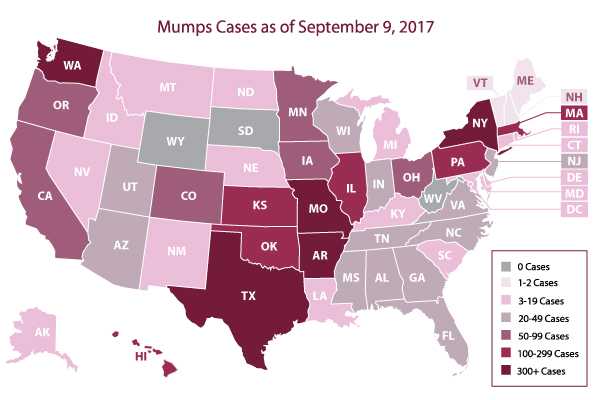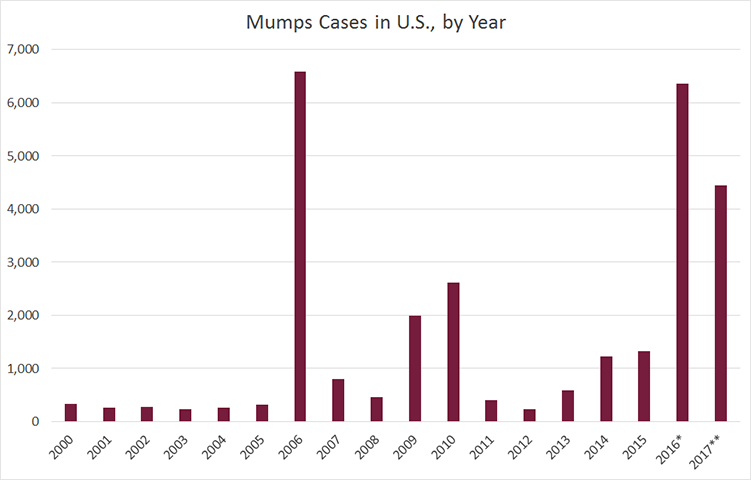Mumps Cases and Outbreaks
Español: Casos y brotes de paperas
Mumps Cases
From January 1 to September 9, 2017, 47 states* and the District of Columbia in the U.S. reported mumps infections in 4,439** people to CDC.
Mumps is no longer very common in the United States. From year to year, mumps cases can range from roughly a couple hundred to a couple thousand. For example in 2016, there were approximately 6,366 cases reported to CDC, and in 2012, there were 229. Before the U.S. mumps vaccination program started in 1967, about 186,000 cases were reported each year, but the actual number of cases was likely much higher due to underreporting. Since the pre-vaccine era, there has been a more than 99% decrease in mumps cases in the United States.

*AL,AK, AZ, AR, CA, CO, CT, DC, DE, FL, GA, HI, ID, IL, IN, IA, KS, KY, LA, ME, MD, MA, MI, MN, MS, MO, MT, NE, NM, NV, NH, NJ, NY, NC, ND, OH, OK, OR, PA, RI, SC, TN, TX, UT, VA, VT, WA, and WI
**Preliminary data reported to CDC. Mumps outbreaks are not reportable.

* Case count is preliminary and subject to change.
**Cases as of September 9, 2017. Case count is preliminary and subject to change.
Source: Morbidity and Mortality Weekly Report (MMWR), Notifiable Diseases and Mortality Tables
Mumps Outbreaks
In some years, there are more cases of mumps than usual because of outbreaks. Mumps outbreaks can occur any time of year. A major factor contributing to outbreaks is being in a crowded environment, such as attending the same class, playing on the same sports team, or living in a dormitory with a person who has mumps. Also, certain behaviors that result in exchanging saliva, such as kissing or sharing utensils, cups, lipstick or cigarettes, might increase spread of the virus.
MMR vaccine prevents most, but not all, cases of mumps and complications caused by the disease. Two doses of the vaccine are 88% (range: 66 to 95%) effective at protecting against mumps; one dose is 78% (range: 49% to 92%) effective. The MMR vaccine protects against currently circulating mumps strains. Outbreaks can still occur in highly vaccinated U.S. communities, particularly in close-contact settings. In recent years, outbreaks have occurred in schools, colleges, and camps. However, high vaccination coverage helps limit the size, duration, and spread of mumps outbreaks.
Although it is not mandatory to report mumps outbreaks to CDC, many health departments will contact CDC when they experience an unusually high number of cases. In 2015 and 2016, a number of cases and outbreaks have been reported to CDC, primarily associated with college settings. These outbreaks have ranged in size from a few to several hundred cases, have mostly affected young adults, and are likely due to a combination of factors. These factors include the known effectiveness of the vaccine, lack of previous exposure to wild-type virus, and the intensity of the exposure setting (such as a college campus) coupled with behaviors that increase the risk of transmission.
Past Mumps Outbreaks
- In 2015-16*, outbreaks were reported from several university campuses, including a number of smaller outbreaks with limited spread. The two largest outbreaks were from Iowa and Illinois, each involving several hundred university students; both held wide-scale vaccination campaigns.
- In 2014, several outbreaks affiliated with universities were reported from multiple states, including one community outbreak in Ohio linked to a university that involved over 400 people, and an outbreak affecting the National Hockey League.
- In 2011-2013, there were several smaller mumps outbreaks reported on college campuses in California, Virginia, and Maryland. However, these all had limited spread, and national case counts for these years were at several hundred cases per year.
- In 2009 to 2010, two large outbreaks occurred.
- One multi-year outbreak involved over 3,000 people and mostly affected high school-aged students who were part of a close-knit religious community in New York City and attended schools in which they had very close contact. The outbreak started when an infected student in this religious community returned from the United Kingdom where a large mumps outbreak was occurring.
- The second outbreak involved about 500 people, mostly school-aged children, in the U.S. Territory of Guam.
- In 2006, the United States experienced a multi-state mumps outbreak involving more than 6,500 reported cases. This resurgence predominantly affected college-aged students living in the Midwest, with outbreaks occurring on many different Midwestern college campuses.
- For more information about mumps outbreaks see Mumps Outbreak Articles.
*Information as of June 1, 2016.
For General Public
For Health Professionals
Related Page
- Page last reviewed: July 27, 2016
- Page last updated: September 20, 2017
- Content source:


 ShareCompartir
ShareCompartir